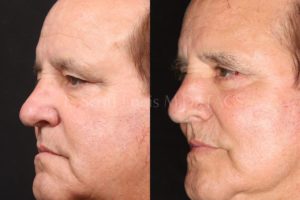A facelift, also known as a rhytidectomy, is a surgical procedure that is designed to improve the appearance of the face by tightening the skin and underlying tissues. This can help to reduce wrinkles and sagging skin, while giving the face a more youthful and rejuvenated appearance.
There are different types of facelifts that a plastic surgeon can perform, and each type is designed to address specific concerns and achieve different results.
Two of the most common types of facelifts are the:
- SMAS (superficial musculoaponeurotic system) facelift
- Deep plane facelift
SMAS Facelift
The SMAS facelift is a more traditional approach to facial rejuvenation. In this procedure, the surgeon makes an incision in the hairline at the temple, extends it down in front of the ear, and then around the earlobe and back into the hairline at the nape of the neck. The surgeon then lifts the skin and underlying tissue, and tightens it to improve the contours of the face. This type of facelift can help to improve the appearance of sagging skin, wrinkles, and other signs of aging on the face and neck.
One of the main advantages of the SMAS facelift is that it is a relatively quick and straightforward procedure. It is also less invasive than other types of facelifts, which means that it has a shorter recovery time and fewer complications. However, the results of a SMAS facelift are not as dramatic as those of other types of facelifts, and they may not last as long.
Deep Plane Facelift
On the other hand, the deep plane facelift is a more comprehensive and advanced technique for facial rejuvenation. In this procedure, the surgeon makes an incision in the hairline at the temple, extends it down in front of the ear, and then around the earlobe and back into the hairline at the nape of the neck. The surgeon then lifts the skin and underlying tissue, but instead of tightening just the superficial layers of tissue, the surgeon also tightens the deeper layers of the face, including the muscles and other structures that support the skin.
The deep plane facelift is a more extensive and involved procedure than the SMAS facelift, and it requires a higher level of skill and expertise on the part of the surgeon. However, the results of a deep plane facelift are more dramatic and long-lasting than those of a SMAS facelift. The deep plane facelift can help to improve the appearance of sagging skin, wrinkles, and other signs of aging on the face and neck, and it can also improve the overall shape and contours of the face.
Deep Plane Facelift Actual Patient Before & After Photos




Advantages of Deep Plane Facelift
One of the main advantages of the deep plane facelift is that it can provide more natural-looking results than other types of facelifts. Because the surgeon tightens the deeper layers of the face, the skin is able to retain its natural shape and contours, which can help to avoid the "pulled" or "windswept" appearance that can sometimes occur with other types of facelifts. Additionally, the results of a deep plane facelift tend to last longer than those of other types of facelifts, which means that patients can enjoy a more youthful and rejuvenated appearance for a longer period of time.
Which is right for you? Call us to find out.
In conclusion, both the SMAS facelift and the deep plane facelift are effective techniques for facial rejuvenation. The SMAS facelift is a less invasive procedure that can provide relatively quick and straightforward results, while the deep plane facelift is a more comprehensive and advanced technique that can provide more dramatic and long-lasting results. Dr. Ennis is a facelift surgeon specialist and board certified plastic surgeon.
To book a consultation click here or call 561-405-9020.
